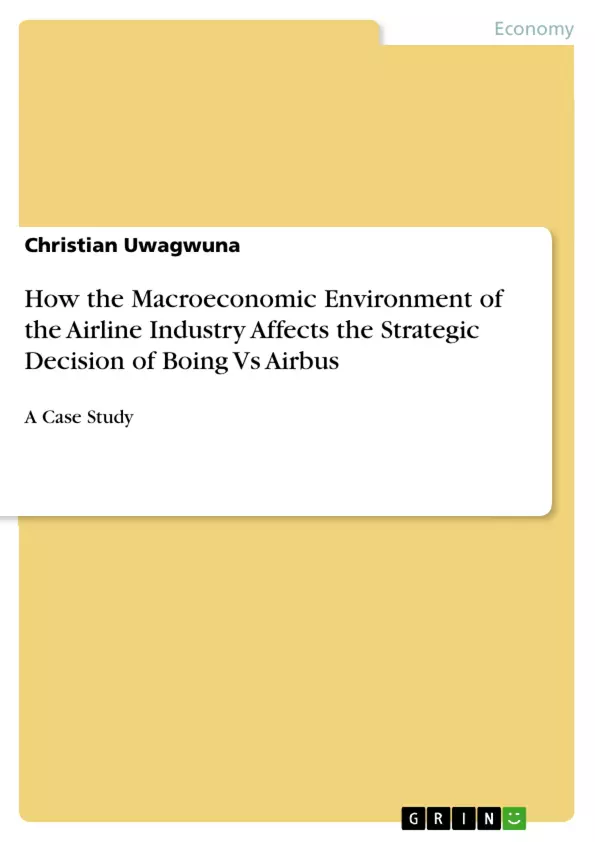This paper discusses the external economic factors affecting the strategic decision of airline industry and how this decision in turn, affect the market forecast of the aircraft manufacturing industry. Various business issues affect airlines operation either directly and indirectly, and these issues affect the strategic decision of the airline industry. The present economic crisis, instability in aviation fuel price, and environmental factors (such as the recent volcanic ashes and snow) has further shrunk business in the airline industry and thereby increasing competitive rivalry. Although the future projected growth by the airline industry look promising, factors affecting airline businesses can make it daunting. Strategic decisions however, will help the airlines to maximize this positive forecast. To make these decisions, it is vital for the origination to understand the macro-economic environment affecting the airline industry. [...]
Inhaltsverzeichnis (Table of Contents)
- Part A: External Economic Factors Affecting Airline Industry
- Introduction
- Current Business Issues and Trends in Airline Industry
Zielsetzung und Themenschwerpunkte (Objectives and Key Themes)
The objective of this paper is to analyze the operating environment of the airline industry using the PEST framework and identify factors affecting airline business practices. The analysis considers the impact of macroeconomic factors on strategic decisions within the airline industry, specifically focusing on the interplay between the airline industry and aircraft manufacturers (Boeing and Airbus).
- Macroeconomic factors influencing the airline industry
- Strategic decision-making in the airline industry
- Competitive dynamics between Boeing and Airbus
- Impact of deregulation on the airline industry
- Analysis of the airline industry using PESTEL and Porter's Five Forces frameworks
Zusammenfassung der Kapitel (Chapter Summaries)
Part A: External Economic Factors Affecting Airline Industry: This section provides a comprehensive overview of the external economic factors impacting the airline industry. It begins by introducing the airline industry's significant growth and its role in globalization, noting the shift from government control to deregulation and the resulting increased competition. The section then delves into current business issues and trends, highlighting challenges such as competition from low-cost carriers, volatile fuel prices, and the impact of enhanced security measures post-9/11. These factors have negatively affected airline revenues, increased operating costs, and created uncertainty in the industry. The analysis uses frameworks like PESTEL and Porter's Five Forces to understand the complex interplay of political, economic, social, technological, environmental, and legal factors that shape the airline industry's operating environment. The significance of these factors is emphasized by their direct influence on airlines' strategic decisions and their indirect impact on the aircraft manufacturing industry, particularly the competition between Boeing and Airbus.
Schlüsselwörter (Keywords)
Airline industry, macroeconomic environment, strategic decision-making, Boeing, Airbus, PESTEL analysis, Porter's Five Forces, deregulation, competition, fuel prices, security measures, low-cost carriers.
Frequently Asked Questions: Comprehensive Language Preview of Airline Industry Analysis
What is the purpose of this document?
This document provides a comprehensive preview of a paper analyzing the airline industry's operating environment. It includes a table of contents, objectives and key themes, chapter summaries, and keywords.
What are the main objectives of the paper?
The paper aims to analyze the airline industry's operating environment using the PEST framework, identify factors affecting airline business practices, and examine the impact of macroeconomic factors on strategic decisions. It specifically focuses on the relationship between the airline industry and aircraft manufacturers (Boeing and Airbus).
What key themes are explored in the paper?
Key themes include macroeconomic factors influencing the airline industry, strategic decision-making within the industry, competitive dynamics between Boeing and Airbus, the impact of deregulation, and analysis using PESTEL and Porter's Five Forces frameworks.
What is covered in Part A: External Economic Factors Affecting the Airline Industry?
Part A provides an overview of external economic factors impacting the airline industry. It covers the industry's growth, the shift from government control to deregulation, increased competition, challenges from low-cost carriers, volatile fuel prices, post-9/11 security measures' impact, and the use of PESTEL and Porter's Five Forces frameworks for analysis.
What frameworks are used in the analysis?
The analysis utilizes the PESTEL framework and Porter's Five Forces framework to understand the complex interplay of factors shaping the airline industry's operating environment.
What is the significance of Boeing and Airbus in this analysis?
The analysis considers the interplay between the airline industry and the aircraft manufacturing industry, particularly the competition between Boeing and Airbus, and how this is impacted by macroeconomic factors and airline strategic decisions.
What are the key words associated with this paper?
Key words include: Airline industry, macroeconomic environment, strategic decision-making, Boeing, Airbus, PESTEL analysis, Porter's Five Forces, deregulation, competition, fuel prices, security measures, low-cost carriers.
What type of document is this?
This is a language preview intended for academic use, providing a structured overview of the themes and content of a larger research paper.
- Quote paper
- BA Christian Uwagwuna (Author), 2011, How the Macroeconomic Environment of the Airline Industry Affects the Strategic Decision of Boing Vs Airbus, Munich, GRIN Verlag, https://www.grin.com/document/170506



